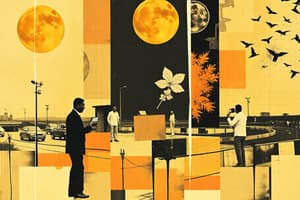Podcast
Questions and Answers
Which article is used for feminine singular nouns in Hindi?
Which article is used for feminine singular nouns in Hindi?
- di (correct)
- der
- das
- du
What is the typical word order in Hindi sentences?
What is the typical word order in Hindi sentences?
- Object-Verb-Subject
- Verb-Subject-Object
- Subject-Verb-Object
- Subject-Object-Verb (correct)
How many gender categories do Hindi nouns have?
How many gender categories do Hindi nouns have?
- Five
- Two
- Three (correct)
- Four
Which language has a word order most similar to Hindi?
Which language has a word order most similar to Hindi?
How many pronouns does Hindi have?
How many pronouns does Hindi have?
What does the affix in a Hindi verb indicate?
What does the affix in a Hindi verb indicate?
Which Indo-Aryan language shares a large number of words with Hindi due to their roots in Sanskrit?
Which Indo-Aryan language shares a large number of words with Hindi due to their roots in Sanskrit?
Who is known for writing the epic poetry Ramayana in Old Hindi literature?
Who is known for writing the epic poetry Ramayana in Old Hindi literature?
Which author's works in modern Hindi literature address issues of land reform and social justice?
Which author's works in modern Hindi literature address issues of land reform and social justice?
In Hindi literature, what themes does Amrita Pritam's poetry explore?
In Hindi literature, what themes does Amrita Pritam's poetry explore?
Which Hindi film contributed to popularizing Hindi literature themes and language through cinema?
Which Hindi film contributed to popularizing Hindi literature themes and language through cinema?
How has Hindi theater contributed to the evolution of the language and its cultural context?
How has Hindi theater contributed to the evolution of the language and its cultural context?
Flashcards are hidden until you start studying
Study Notes
Hindi: Exploring Grammar and Literature
Hindi, the fourth most widely spoken language in the world, is a rich and diverse language with a fascinating history and unique grammar. In this article, we'll delve into the intricacies of both the grammatical structure and the literary heritage of Hindi, uncovering the elements that have shaped this multi-faceted language.
Hindi Grammar
Hindi, belonging to the Indo-Aryan branch of the Indo-European language family, follows a relatively simple structure with many linguistic features unique to the language.
Nouns and articles Hindi employs a robust system of gender, with nouns categorized as masculine, feminine, and neuter. Each gender has its own specific article: "der" (masculine singular), "di" (feminine singular), and "du" (neuter singular).
Verbs and conjugation Hindi verbs follow a complex conjugation system, with separate forms for each person, number, tense, and mood. The structure of a typical verb in Hindi consists of a base form, an affix (or auxiliary verb) that indicates tense, and a suffix that indicates person, number, and mood.
Word order and sentence structure Hindi follows a subject-object-verb (SOV) word order, which is different from standard English. However, it's quite similar to French, German, and Japanese.
Pronouns and case Hindi has eight pronouns, which can be used in different case forms, such as nominative, accusative, genitive, dative, ablative, and locative.
Hindi vocabulary Hindi shares a large number of words with other Indo-Aryan languages such as Urdu, Punjabi, and Bengali, due to its roots in Sanskrit. However, it also borrows words from Persian, Arabic, and English.
Hindi Literature
Hindi literature is a rich tapestry of narratives, poetry, and plays that span over a millennium and reflect the cultural, political, and social evolution of India.
Old Hindi literature Old Hindi literature, from the 11th to 18th centuries, is characterized by devotional texts, epic poetry, and refined poetic forms. Key figures in Old Hindi literature include poets such as Tulsidas, Surdas, and Narsinh Mehta, who wrote Ramayana, Bhagavata Purana, and Vaishnava Bhakti poetry, respectively.
Modern Hindi literature Modern Hindi literature, from the 19th century onward, is marked by the use of colloquial language, social commentary, and experimental forms. Notable authors from this period include Premchand, Munshi Premchand, and Amrita Pritam. Premchand's works, such as "Godan" and "Kafan," address issues of land reform and social justice, while Amrita Pritam's poetry, such as "Aj aakhan deku hain" and "Sune rahi hai," explores themes of love, identity, and justice.
Hindi theater and cinema Hindi theater and cinema have played a significant role in the evolution of the language and literary tradition. With the advent of films such as "Mother India," "Sholay," "3 Idiots," and "Gangs of Wasseypur," Hindi cinema has brought Hindi literature to the masses and popularized its themes and language. Similarly, Hindi theater, with its rich legacy of plays and performances, has helped shape the language and its cultural context.
In conclusion, Hindi is a fascinating language with a rich grammatical structure and a diverse literary heritage. From its roots in Old Hindi literature to its modern expressions in theater and cinema, the language continues to evolve and inspire, shaping the cultural landscape of India and the world at large.
Studying That Suits You
Use AI to generate personalized quizzes and flashcards to suit your learning preferences.




